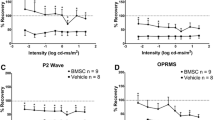Abstract
A number of retinal degenerative diseases may be amenable to treatment with continuous intraocular delivery of therapeutic agents that cannot be delivered effectively to the retina via systemic or topical administration. Among these disorders are lysosomal storage diseases resulting from deficiencies in soluble lysosomal enzymes. Most cells, including those of the retina, are able to take up these enzymes and incorporate them in active form into their lysosomes. In theory, therefore, continuous intraocular administration of a normal form of a soluble lysosomal enzyme should be able to cure the molecular defect in the retinas of subjects lacking this enzyme. Experiments were conducted to determine whether genetically modified bone marrow-derived stem cells implanted into the vitreous could be used as vehicles for continuous delivery of such enzymes to the retina. Bone marrow-derived mesenchymal stem cells (MSCs) from normal mice were implanted into the vitreous of mice undergoing retinal degeneration as a result of a mutation in the PPT1 gene. The implanted cells appeared to survive indefinitely in the vitreous without proliferating or invading the retina. This indicates that intravitreal implantation of MSCs is likely a safe means of long-term delivery of proteins synthesized by the implanted cells. Experiments have been initiated to test the efficacy of using genetically modified autologous MSCs to inhibit retinal degeneration in a canine model of neuronal ceroid lipofuscinosis.
Access this chapter
Tax calculation will be finalised at checkout
Purchases are for personal use only
Similar content being viewed by others
References
Awano T, Katz ML, Sohar I, Lobel P, Coates JR, Khan S, Johnson GC, Giger U, Johnson GS (2006) A frame shift mutation in the canine ortholog of human CLN2 in a juvenile dachshund with neuronal ceroid lipofuscinosis. Mol Genet Matabol 89:254–260
Frimberger AE, Moore AS, Rassnick KM, Cotter SM, O’Sullivan JL, Quesenberry PJ (2006) A combination chemotherapy protocol with dose intensification and autologous bone marrow transplant (VELCAP-HDC) for canine lymphoma. J Vet Intern Med 20:355–364
Gupta P, Soyombo AA, Atasgband A, Wysniewski KE, Shelton JM, Richardson JA, Hammer RE, Hofmann SL (2001) Disruption of PPT1 or PPT2 causes neuronal ceroid lipofuscinosis in knockout mice. Proc Nat Acad Sci U S A 98:13566–13571
Katz ML, Coates JR, Cooper JJ, O’Brien DP, Jeong M, Narfström K (2008) Retinal pathology in a canine model of late infantile neuronal ceroid lipofuscinosis. Invest Ophthalmol Vis Sci 49:2686–2695
Lei B, Tullis GE, Kirk MD, Zhang K, Katz ML (2006) Ocular phenotype in a mouse gene knockout model for infantile neuronal ceroid-lipofuscinosis. J Neurosci Res 84:1139–1149
Meyer JS, Katz ML, Maruniak JA, Kirk MD (2006) Embryonic stem cell derived neural precursors incorporate into the degenerating retina and enhance survival of host photoreceptors. Stem Cells 24:274–283
Ramsden CM, Powner MB, Carr AJ, Smart MJ, da Cruz L, Coffey PJ (2013) Stem cells in retinal regeneration: past, present and future. Development 140:2576–2585
Tian Y, Sohar I, Taylor JW, Lobel P (2006) Determination of the substrate specificity of tripeptidyl-peptidase I using combinatorial peptide libraries and development of improved fluorogenic substrates. J Biol Chem 281:6559–6572
Williams AR, Hare JM (2011) Mesenchymal stem cells: biology, pathophysiology, translational findings, and therapeutic implications for cardiac disease. Circ Res 109:923–940
Acknowledgments
This work was supported in part by grants 1R01EY018815 and 1R01EY023968 from the U.S. National Institutes of Health. We thank Lauren E. Gillespie for technical assistance and Dr. Mark Sands for the founder PPT1−/− mice.
Author information
Authors and Affiliations
Corresponding author
Editor information
Editors and Affiliations
Rights and permissions
Copyright information
© 2016 Springer International Publishing Switzerland
About this paper
Cite this paper
Tracy, C. et al. (2016). Intravitreal Implantation of Genetically Modified Autologous Bone Marrow-Derived Stem Cells for Treating Retinal Disorders. In: Bowes Rickman, C., LaVail, M., Anderson, R., Grimm, C., Hollyfield, J., Ash, J. (eds) Retinal Degenerative Diseases. Advances in Experimental Medicine and Biology, vol 854. Springer, Cham. https://doi.org/10.1007/978-3-319-17121-0_76
Download citation
DOI: https://doi.org/10.1007/978-3-319-17121-0_76
Published:
Publisher Name: Springer, Cham
Print ISBN: 978-3-319-17120-3
Online ISBN: 978-3-319-17121-0
eBook Packages: Biomedical and Life SciencesBiomedical and Life Sciences (R0)




